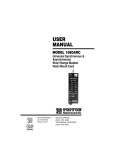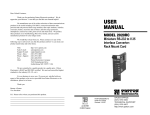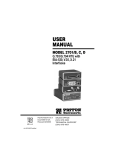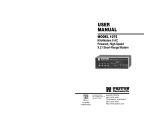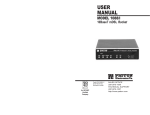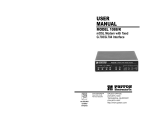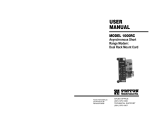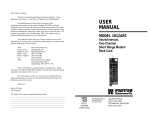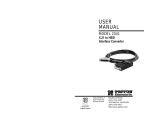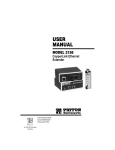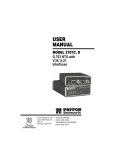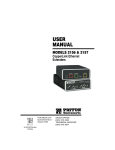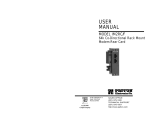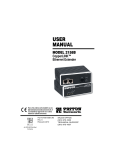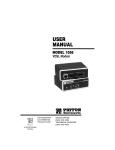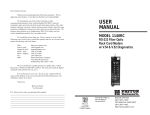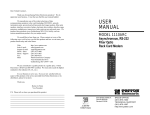Download USER MANUAL MODEL 1206RC Synchronous X.21 Modem
Transcript
Dear Valued Customer, Thank you for purchasing Patton Electronics products! We do appreciate your business. I trust that you find this user manual helpful. USER MANUAL We manufacture one of the widest selections of data communications products in the world including CSU/DSU's, network termination units, powered and self-powered short range modems, fiber optic modems, interface converters, baluns, electronic data switches, data-line surge protectors, multiplexers, transceivers, hubs, print servers and much more. We produce these products at our Gaithersburg, MD, USA, facility, and can custom manufacture products for your unique needs. MODEL 1206RC Synchronous X.21 Modem Eliminator: Rack Mount Card We would like to hear from you. Please contact us in any of the following ways to tell us how you like this product and how we can meet your product needs today and in the future. Web: Sales E-mail: Support E-mail: Phone - Sales Phone - Support Fax: Mail: http://www.patton.com [email protected] [email protected] (301) 975-1000 (301) 975-1007 (301) 869-9293 Patton Electronics Company 7622 Rickenbacker Drive Gaithersburg, MD 20879 USA We are committed to a quality product at a quality price. Patton Electronics is ISO 9001 certified. We meet and exceed the highest standards in the industry (CE, UL, etc.). It is our business to serve you. If you are not satisfied with any aspect of this product or the service provided from Patton Electronics or its distributors, please let us know. Thank you. Burton A.Patton Vice President P.S. Please tell us where you purchased this product. _________________________________________________________ _________________________________________________________ _________________________________________________________ _________________________________________________________ _________________________________________________________ Part# 07M1206RC-C Doc# 049061U, Rev. D Revised 1/22/08 An ISO-9001 Certified Company SALES OFFICE (301) 975-1000 TECHNICAL SUPPORT (301) 975-1007 http://www.patton.com 1.0 WARRANTY INFORMATION 1.3 SERVICE Patton Electronics warrants all Model 1206RC components to be free from defects, and will—at our option—repair or replace the product should it fail within one year from the first date of shipment. This warranty is limited to defects in workmanship or materials, and does not cover customer damage, abuse or unauthorized modification. If this product fails or does not perform as warranted, your sole recourse shall be repair or replacement as described above. Under no condition shall Patton Electronics be liable for any damages incurred by the use of this product. These damages include, but are not limited to, the following: lost profits, lost savings and incidental or consequential damages arising from the use of or inability to use this product. Patton Electronics specifically disclaims all other warranties, expressed or implied, and the installation or use of this product shall be deemed an acceptance of these terms by the user. All warranty and non-warranty repairs must be returned freight prepaid and insured to Patton Electronics. All returns must have a Return Materials Authorization number on the outside of the shipping container. This number may be obtained from Patton Electronics Technical Service at (301) 975-1007. Packages received without an RMA number will not be accepted. Patton Electronics’ technical staff is also available to answer any questions that might arise concerning the installation or use of your Model 1206RC. Technical Service hours: 8AM to 5PM EST, Monday through Friday. 1.1 RADIO AND TV INTERFERENCE The Model 1206RC generates and uses radio frequency energy, and if not installed and used properly—that is, in strict accordance with the manufacturer’s instructions—may cause interference to radio and television reception. The Model 1206RC has been tested and found to comply with the limits for a Class A computing device in accordance with the specifications in Subpart J of Part 15 of FCC rules, which are designed to provide reasonable protection from such interference in a commercial installation. However, there is no guarantee that interference will not occur in a particular installation. If the Model 1206RC does cause interference to radio or television reception, which can be determined by turning the power off or removing the card, the user is encouraged to try to correct the interference by one or more of the following measures: moving the computing equipment away from the receiver, re-orienting the receiving antenna and/or plugging the receiving equipment into a different AC outlet (such that the computing equipment and receiver are on different branches). In the event the user detects intermittent or continuous product malfunction due to nearby high power transmitting radio frequency equipment, the user is strongly advised to take the following steps: use only data cables with an external outer shield bonded to a metal or metalized connector; and, configure the rear card as shown in section 3.4 of this manual. 1.2 CE NOTICE The CE symbol on your Patton Electronics equipment indicates that it is in compliance with the Electromagnetic Compatibility (EMC) directive and the Low Voltage Directive (LVD) of the Union European (EU). A Certificate of Compliance is available by contacting Technical Support. 1 2 1.0 WARRANTY INFORMATION 1.3 SERVICE Patton Electronics warrants all Model 1206RC components to be free from defects, and will—at our option—repair or replace the product should it fail within one year from the first date of shipment. This warranty is limited to defects in workmanship or materials, and does not cover customer damage, abuse or unauthorized modification. If this product fails or does not perform as warranted, your sole recourse shall be repair or replacement as described above. Under no condition shall Patton Electronics be liable for any damages incurred by the use of this product. These damages include, but are not limited to, the following: lost profits, lost savings and incidental or consequential damages arising from the use of or inability to use this product. Patton Electronics specifically disclaims all other warranties, expressed or implied, and the installation or use of this product shall be deemed an acceptance of these terms by the user. All warranty and non-warranty repairs must be returned freight prepaid and insured to Patton Electronics. All returns must have a Return Materials Authorization number on the outside of the shipping container. This number may be obtained from Patton Electronics Technical Service at (301) 975-1007. Packages received without an RMA number will not be accepted. Patton Electronics’ technical staff is also available to answer any questions that might arise concerning the installation or use of your Model 1206RC. Technical Service hours: 8AM to 5PM EST, Monday through Friday. 1.1 RADIO AND TV INTERFERENCE The Model 1206RC generates and uses radio frequency energy, and if not installed and used properly—that is, in strict accordance with the manufacturer’s instructions—may cause interference to radio and television reception. The Model 1206RC has been tested and found to comply with the limits for a Class A computing device in accordance with the specifications in Subpart J of Part 15 of FCC rules, which are designed to provide reasonable protection from such interference in a commercial installation. However, there is no guarantee that interference will not occur in a particular installation. If the Model 1206RC does cause interference to radio or television reception, which can be determined by turning the power off or removing the card, the user is encouraged to try to correct the interference by one or more of the following measures: moving the computing equipment away from the receiver, re-orienting the receiving antenna and/or plugging the receiving equipment into a different AC outlet (such that the computing equipment and receiver are on different branches). In the event the user detects intermittent or continuous product malfunction due to nearby high power transmitting radio frequency equipment, the user is strongly advised to take the following steps: use only data cables with an external outer shield bonded to a metal or metalized connector; and, configure the rear card as shown in section 3.4 of this manual. 1.2 CE NOTICE The CE symbol on your Patton Electronics equipment indicates that it is in compliance with the Electromagnetic Compatibility (EMC) directive and the Low Voltage Directive (LVD) of the Union European (EU). A Certificate of Compliance is available by contacting Technical Support. 1 2 2.0 GENERAL INFORMATION Thank you for your purchase of this Patton Electronics product. This product has been thoroughly inspected by Patton’s qualified technicians. If any questions or problems arise during installation or use of this product, please do not hesitate to contact Patton Electronics Technical Support at (301) 975-1007; [email protected] or http://www.patton.com. 2.1 FEATURES • X.21 operation • Synchronous data rates from 32 to 144 Kbps 3.0 CONFIGURATION This section describes the location and orientation of the Model 1206RC’s configuration switches and jumpers, and provides detailed instructions for all possible settings. The Model 1206RC uses a combination of DIP switches and jumpers that allow configuration to an extremely wide range of applications. Designed around a mid-plane architecture, the Model 1206RC incorporates both front and rear cards. Configuration of both may be necessary. The switches/jumpers are accessible when the cards are slid out of the rack chassis. Once configured, the Model 1206RC is designed to operate transparently, without need for frequent re-configuration: just set it and forget it! • Host-to-host distances up to 300 feet • Internal, external or receive loopback clocking • All necessary data, clocking and control signals supported • Front panel LEDs show TD and CD activity for each port • Two UD-26 connectors on rear interface card • Switchable 120V or 240V power supply 3.1 FUNCTION CARD CONFIGURATION All switches and jumpers are located on the Model 1206RC’s PC board. To access the PC board, loosen the two thumb screws on the front panel and slide the card out of the chassis. As Figure 1 (below) illustrates, the DIP switches are located on the “daughterboard” and the jumpers are located on the main PC board. • Mounts in Patton’s 16-slot rack chassis and 2/4/8-slot Cluster Boxes DIP Switches 2.2 DESCRIPTION The Patton Model 1206RC synchronous X.21 modem eliminator rack card lets two synchronous X.21 hosts communicate with each other in the same room for a fraction of the cost of a pair of high speed modems. Supporting synchronous data rates of 32, 48, 56, 64, 72, 112, 128 and 144 Kbps, the Model 1206 can be configured for internal, external or receive loopback clock. Maximum distance between the connected hosts is 300 feet, and all necessary data, clocking and control signals are supported. Jumpers Figure 1. Model 1206RC board, showing location of switches/jumpers The Model 1206RC is designed to mount in Patton’s 2U high, 16slot rack chassis, as well as Patton’s 2/4/8-slot desktop Cluster Boxes. This rack chassis and cluster boxes feature a switchable 120/240 VAC power supply (optional 48 VDC) and hot swappable function/interface cards mounted in a mid-plane architecture. Front panel LEDs show TD and CD activity for both ports, as well as power. The rear interface card has two UD-26 connectors for patching to the host devices. 3 3.1.1 FUNCTION CARD DIP SWITCH The Model 1206RC has one four-position DIP switch mounted on the daughterboard. Figure 2 (following page) shows the numbering of the individual switches and their “ON/OFF” positions relative to the daughterboard. 4 2.0 GENERAL INFORMATION Thank you for your purchase of this Patton Electronics product. This product has been thoroughly inspected by Patton’s qualified technicians. If any questions or problems arise during installation or use of this product, please do not hesitate to contact Patton Electronics Technical Support at (301) 975-1007; [email protected] or http://www.patton.com. 2.1 FEATURES • X.21 operation • Synchronous data rates from 32 to 144 Kbps 3.0 CONFIGURATION This section describes the location and orientation of the Model 1206RC’s configuration switches and jumpers, and provides detailed instructions for all possible settings. The Model 1206RC uses a combination of DIP switches and jumpers that allow configuration to an extremely wide range of applications. Designed around a mid-plane architecture, the Model 1206RC incorporates both front and rear cards. Configuration of both may be necessary. The switches/jumpers are accessible when the cards are slid out of the rack chassis. Once configured, the Model 1206RC is designed to operate transparently, without need for frequent re-configuration: just set it and forget it! • Host-to-host distances up to 300 feet • Internal, external or receive loopback clocking • All necessary data, clocking and control signals supported • Front panel LEDs show TD and CD activity for each port • Two UD-26 connectors on rear interface card • Switchable 120V or 240V power supply 3.1 FUNCTION CARD CONFIGURATION All switches and jumpers are located on the Model 1206RC’s PC board. To access the PC board, loosen the two thumb screws on the front panel and slide the card out of the chassis. As Figure 1 (below) illustrates, the DIP switches are located on the “daughterboard” and the jumpers are located on the main PC board. • Mounts in Patton’s 16-slot rack chassis and 2/4/8-slot Cluster Boxes DIP Switches 2.2 DESCRIPTION The Patton Model 1206RC synchronous X.21 modem eliminator rack card lets two synchronous X.21 hosts communicate with each other in the same room for a fraction of the cost of a pair of high speed modems. Supporting synchronous data rates of 32, 48, 56, 64, 72, 112, 128 and 144 Kbps, the Model 1206 can be configured for internal, external or receive loopback clock. Maximum distance between the connected hosts is 300 feet, and all necessary data, clocking and control signals are supported. Jumpers Figure 1. Model 1206RC board, showing location of switches/jumpers The Model 1206RC is designed to mount in Patton’s 2U high, 16slot rack chassis, as well as Patton’s 2/4/8-slot desktop Cluster Boxes. This rack chassis and cluster boxes feature a switchable 120/240 VAC power supply (optional 48 VDC) and hot swappable function/interface cards mounted in a mid-plane architecture. Front panel LEDs show TD and CD activity for both ports, as well as power. The rear interface card has two UD-26 connectors for patching to the host devices. 3 3.1.1 FUNCTION CARD DIP SWITCH The Model 1206RC has one four-position DIP switch mounted on the daughterboard. Figure 2 (following page) shows the numbering of the individual switches and their “ON/OFF” positions relative to the daughterboard. 4 On Figure 4 (below) shows the location of jumpers JP4 and JP5 on the Model 1206RC front card. 4 3 2 1 Top of Card Figure 2. Model 1206RC DIP switch orientation on internal daughterboard. JP4 JP5 S1 through S3: Data Rate Setting Switches S1 through S3 are set in combination to determine the synchronous data rate for the Model 1206RC. Switch S4 is not active. S1 Off On Off On Off On Off On S2 Off Off On On Off Off On On S3 Off Off Off Off On On On On S4 N/A N/A N/A N/A N/A N/A N/A N/A Setting 32 kbps 48 kbps 56 kbps 64 kbps 72 kbps 112 kbps 128 kbps 144 kbps JP5: Clock Source (Port A) The setting for jumper JP5 determines–with respect to Port A– whether clocking is internal or external. Note: Only Port A may be set for external clock. JP5 (Port A) Position 1&2 Position 2&3 Strap Removed 3.3 FUNCTION CARD JUMPERS The Model 1206RC has two ports (Port A and Port B), which must be configured independently for clocking. As Figure 3 (below) shows, each configuration jumper has three possible positions: strap covering posts 1 & 2, strap covering posts 2 & 3, or strap removed altogether. The detailed descriptions for jumpers JP4 and JP5 present all valid strap positions. 1 2 3 1 2 3 1 2 Figure 4. Jumper locations on Model 1206RC front card 3 Setting External Clock Internal Clock (factory default) Not a valid setting JP4: Clock Source (Port B) The setting for jumper JP4 determines–with respect to Port B– whether clocking is internal or receive loopback. Note1: If Port B is set for receive loopback clock, Port A must be set for external clock. Note2: Port B may not be set for external clock. JP4 (Port B) Position 1&2 Position 2&3 Strap Removed Setting Receive Loopback Clock Internal Clock (factory default) Not a valid setting Front of Card Figure 3. Possible function card strap positions 5 6 On Figure 4 (below) shows the location of jumpers JP4 and JP5 on the Model 1206RC front card. 4 3 2 1 Top of Card Figure 2. Model 1206RC DIP switch orientation on internal daughterboard. JP4 JP5 S1 through S3: Data Rate Setting Switches S1 through S3 are set in combination to determine the synchronous data rate for the Model 1206RC. Switch S4 is not active. S1 Off On Off On Off On Off On S2 Off Off On On Off Off On On S3 Off Off Off Off On On On On S4 N/A N/A N/A N/A N/A N/A N/A N/A Setting 32 kbps 48 kbps 56 kbps 64 kbps 72 kbps 112 kbps 128 kbps 144 kbps JP5: Clock Source (Port A) The setting for jumper JP5 determines–with respect to Port A– whether clocking is internal or external. Note: Only Port A may be set for external clock. JP5 (Port A) Position 1&2 Position 2&3 Strap Removed 3.3 FUNCTION CARD JUMPERS The Model 1206RC has two ports (Port A and Port B), which must be configured independently for clocking. As Figure 3 (below) shows, each configuration jumper has three possible positions: strap covering posts 1 & 2, strap covering posts 2 & 3, or strap removed altogether. The detailed descriptions for jumpers JP4 and JP5 present all valid strap positions. 1 2 3 1 2 3 1 2 Figure 4. Jumper locations on Model 1206RC front card 3 Setting External Clock Internal Clock (factory default) Not a valid setting JP4: Clock Source (Port B) The setting for jumper JP4 determines–with respect to Port B– whether clocking is internal or receive loopback. Note1: If Port B is set for receive loopback clock, Port A must be set for external clock. Note2: Port B may not be set for external clock. JP4 (Port B) Position 1&2 Position 2&3 Strap Removed Setting Receive Loopback Clock Internal Clock (factory default) Not a valid setting Front of Card Figure 3. Possible function card strap positions 5 6 4.0 INSTALLATION 3.4 REAR CARD CONFIGURATION The rear interface card for the Model 1206RC is equipped with two female UD-26 connectors: one for each DTE host port. This card has one configuration jumper (JB4). Figure 5 (below) shows the location of this jumper on the PC board. This section describes the functions of the Model 1000R16 rack chassis, tells how to install front and rear Model 1206RC cards into the chassis, and provides diagrams for wiring the interface connections correctly. 4.1 THE MODEL 1000R16 RACK CHASSIS The Model 1000R16 Rack Chassis (Figure 6) has sixteen card slots, plus its own power supply. Measuring only 3.5” high, the Model 1000R16 is designed to occupy only 2U in a 19” rack. Sturdy front handles allow the Model 1000R16 to be extracted and transported conveniently. JB4 (peg 1 toward bottom of card, peg 3 toward top of card) Figure 5. Rear card jumper location SGND & FRGND (JB4) In the connected position, this jumper links UD-26 pin 7 (Signal Ground) and frame ground. In the open position, pin 1 is “lifted” from frame ground. JB4 Position 1&2 = SGND (UD-26 pin 7) and FRGND Connected Position 2&3 = SGND (UD-26 pin 7) and FRGND Not Connected Figure 6. Model 1000R16 Rack Chassis with power supply 4.1.1 THE RACK POWER SUPPLY The power supply included in the Model 1000R16 rack uses the same mid-plane architecture as the modem cards. The front card of the power supply slides in from the front, and the rear card slides in from the rear. They plug into one another in the middle of the rack. The front card is then secured by thumb screws and the rear card by conventional metal screws. WARNING! There are no user-serviceable parts in the power supply section of the Model 1206RC. Voltage setting changes and fuse replacement should only be performed by qualified service personnel. Contact Patton Electronics Technical support at (301)975-1007, http://www.patton.com, or [email protected] for more information. 7 8 4.0 INSTALLATION 3.4 REAR CARD CONFIGURATION The rear interface card for the Model 1206RC is equipped with two female UD-26 connectors: one for each DTE host port. This card has one configuration jumper (JB4). Figure 5 (below) shows the location of this jumper on the PC board. This section describes the functions of the Model 1000R16 rack chassis, tells how to install front and rear Model 1206RC cards into the chassis, and provides diagrams for wiring the interface connections correctly. 4.1 THE MODEL 1000R16 RACK CHASSIS The Model 1000R16 Rack Chassis (Figure 6) has sixteen card slots, plus its own power supply. Measuring only 3.5” high, the Model 1000R16 is designed to occupy only 2U in a 19” rack. Sturdy front handles allow the Model 1000R16 to be extracted and transported conveniently. JB4 (peg 1 toward bottom of card, peg 3 toward top of card) Figure 5. Rear card jumper location SGND & FRGND (JB4) In the connected position, this jumper links UD-26 pin 7 (Signal Ground) and frame ground. In the open position, pin 1 is “lifted” from frame ground. JB4 Position 1&2 = SGND (UD-26 pin 7) and FRGND Connected Position 2&3 = SGND (UD-26 pin 7) and FRGND Not Connected Figure 6. Model 1000R16 Rack Chassis with power supply 4.1.1 THE RACK POWER SUPPLY The power supply included in the Model 1000R16 rack uses the same mid-plane architecture as the modem cards. The front card of the power supply slides in from the front, and the rear card slides in from the rear. They plug into one another in the middle of the rack. The front card is then secured by thumb screws and the rear card by conventional metal screws. WARNING! There are no user-serviceable parts in the power supply section of the Model 1206RC. Voltage setting changes and fuse replacement should only be performed by qualified service personnel. Contact Patton Electronics Technical support at (301)975-1007, http://www.patton.com, or [email protected] for more information. 7 8 Switching the Power Supply On and Off 4.3 HOST (DTE) CONNECTION The power supply on/off switch is located on the front panel. When plugged in and switched on, a red front panel LED will glow. Since the Model 1000R16 is a “hot swappable” rack, it is not necessary for any cards to be installed before switching on the power supply. The power supply may be switched off at any time without harming the installed cards. The Model 1206RC rear card has two UD-26 connectors, labeled “A1” and “B1” (see figure 7, below). These correspond to host (DTE) connection Port A and Port B, as discussed in Section 3.0. A1 B1 NOTE: Please refer to the Model 1000RP Series User Manual AC and DC Rack Mount Power Supplies for fuse and power card replacement information. 4.2 INSTALLING THE MODEL 1206RC INTO THE CHASSIS The Model 1206RC is comprised of a front card and a rear card. The two cards meet inside the rack chassis and plug into each other by way of mating 50 pin card edge connectors. Use the following steps as a guideline for installing each Model 1206RC into the rack chassis: Figure 7. Model 1206RC rear interface card, showing connectors 1. Slide the rear card into the back of the chassis along the metal rails provided. 2. Secure the rear card using the metal screws provided. 3. Slide the card into the front of the chassis. It should meet the rear card when it’s almost all the way into the chassis. 4. Push the front card gently into the card-edge receptacle of the rear card. It should “click” into place. 5. Secure the front card using the thumb screws. NOTE: Since the Model 1000R16 chassis allows “hot swapping” of cards, it is not necessary to power down the rack when you install or remove a Model 1206RC. To connect X.21 host (DTE) devices A and B to the Model 1206RC, follow these instructions: 1. Configure the Model 1206RC for your specific application according to the instructions in Section 3.0 of this manual. 2. Connect host devices A and B to the Model 1206RC using multipair adapter cables (see Appendix B for a list of custom adapter cables available from Patton Electronics). Observe the following conditions when making connections : a) Each multipair cable must not exceed 150 feet in length. b) If external clock is used, the host (DTE) device supplying the clock must be connected to Port A. The Model 1206RC cannot receive an external clock on Port B (see Section 3.0 for configuration details). c) If receive clock is used on Port B, Port A must supply an external clock (see Section 3.0 for configuration details). Notice! Any terminal cable connected to the Model 1206RC must be shielded cable, and the outer shield must be 360 degree bonded–at both ends–to a metal or metalized backshell. 9 10 Switching the Power Supply On and Off 4.3 HOST (DTE) CONNECTION The power supply on/off switch is located on the front panel. When plugged in and switched on, a red front panel LED will glow. Since the Model 1000R16 is a “hot swappable” rack, it is not necessary for any cards to be installed before switching on the power supply. The power supply may be switched off at any time without harming the installed cards. The Model 1206RC rear card has two UD-26 connectors, labeled “A1” and “B1” (see figure 7, below). These correspond to host (DTE) connection Port A and Port B, as discussed in Section 3.0. A1 B1 NOTE: Please refer to the Model 1000RP Series User Manual AC and DC Rack Mount Power Supplies for fuse and power card replacement information. 4.2 INSTALLING THE MODEL 1206RC INTO THE CHASSIS The Model 1206RC is comprised of a front card and a rear card. The two cards meet inside the rack chassis and plug into each other by way of mating 50 pin card edge connectors. Use the following steps as a guideline for installing each Model 1206RC into the rack chassis: Figure 7. Model 1206RC rear interface card, showing connectors 1. Slide the rear card into the back of the chassis along the metal rails provided. 2. Secure the rear card using the metal screws provided. 3. Slide the card into the front of the chassis. It should meet the rear card when it’s almost all the way into the chassis. 4. Push the front card gently into the card-edge receptacle of the rear card. It should “click” into place. 5. Secure the front card using the thumb screws. NOTE: Since the Model 1000R16 chassis allows “hot swapping” of cards, it is not necessary to power down the rack when you install or remove a Model 1206RC. To connect X.21 host (DTE) devices A and B to the Model 1206RC, follow these instructions: 1. Configure the Model 1206RC for your specific application according to the instructions in Section 3.0 of this manual. 2. Connect host devices A and B to the Model 1206RC using multipair adapter cables (see Appendix B for a list of custom adapter cables available from Patton Electronics). Observe the following conditions when making connections : a) Each multipair cable must not exceed 150 feet in length. b) If external clock is used, the host (DTE) device supplying the clock must be connected to Port A. The Model 1206RC cannot receive an external clock on Port B (see Section 3.0 for configuration details). c) If receive clock is used on Port B, Port A must supply an external clock (see Section 3.0 for configuration details). Notice! Any terminal cable connected to the Model 1206RC must be shielded cable, and the outer shield must be 360 degree bonded–at both ends–to a metal or metalized backshell. 9 10 5.0 OPERATION 5.2 POWER-UP Once you have configured the Model 1206RC and connected the cables to host A and host B, you are ready to operate the unit. This section describes the LED status monitors and power-up procedure. 5.1 LED STATUS MONITORS The Model 1206RC features 9 front panel status LEDs that indicate the condition of the Model 1206RC and the two ports, A & B (see Figure 9, above): There is no power switch on the Model 1206RC: Power is automatically applied to the 1206RC when its card-edge connector makes contact with the chassis’ mid-plane socket, or when the chassis’ power supply is turned on. Note: The 1206RC is a “hot swappable” card—it will not be damaged by plugging it in or removing it while the rack is powered up. When the Model 1206RC is powered up, and both ports are passing data normally, the following LED conditions will exist: • PWR = green • TD = blinking red and green • CD = green Figure 9. Model 1206RC front panel, showing LED indicators. • The green “PWR” LED glows when power is applied to the Model 1206RC through its mid-plane chassis connection. • Two “TD” LEDs monitor the status of each port’s data transmission. The red LED glows when the signal is in an idle (negative) state. The green LED glows when the signal is in a transmitting (positive) state. Both LEDs will normally blink when data transmission is occurring. • Two “CD” LEDs monitor the status of each port’s carrier detect signal. The red LED glows when the receive channel is not active (negative condition). The green LED glows when the receive channel is active (positive condition). 11 12 5.0 OPERATION 5.2 POWER-UP Once you have configured the Model 1206RC and connected the cables to host A and host B, you are ready to operate the unit. This section describes the LED status monitors and power-up procedure. 5.1 LED STATUS MONITORS The Model 1206RC features 9 front panel status LEDs that indicate the condition of the Model 1206RC and the two ports, A & B (see Figure 9, above): There is no power switch on the Model 1206RC: Power is automatically applied to the 1206RC when its card-edge connector makes contact with the chassis’ mid-plane socket, or when the chassis’ power supply is turned on. Note: The 1206RC is a “hot swappable” card—it will not be damaged by plugging it in or removing it while the rack is powered up. When the Model 1206RC is powered up, and both ports are passing data normally, the following LED conditions will exist: • PWR = green • TD = blinking red and green • CD = green Figure 9. Model 1206RC front panel, showing LED indicators. • The green “PWR” LED glows when power is applied to the Model 1206RC through its mid-plane chassis connection. • Two “TD” LEDs monitor the status of each port’s data transmission. The red LED glows when the signal is in an idle (negative) state. The green LED glows when the signal is in a transmitting (positive) state. Both LEDs will normally blink when data transmission is occurring. • Two “CD” LEDs monitor the status of each port’s carrier detect signal. The red LED glows when the receive channel is not active (negative condition). The green LED glows when the receive channel is active (positive condition). 11 12 APPENDIX A APPENDIX B PATTON MODEL 1206RC SPECIFICATIONS FACTORY REPLACEMENT PARTS Transmission Format: Synchronous, ITU/CCITT X.21 Internal Interface: Connection to Model 1000R16 rack chassis via male card edge External Interface: UD-26 female, ports A1 and B1 Data Rates: 32, 48, 56, 64, 72, 112, 128 and 144 Kbps Clocking: Internal, external or receive loopback Distance: 300 feet (DTE to DTE) Indicators: Independent Bi-color LED indicators for each port: TD and CD; common “Power” indicator Power Supply: Rack-mount power supply is switchable between 120V and 240V AC; chassis supplies 10V AC to the Model 1206RC, typical consumption is 700mW Temperature: 0-50°C / 32-122°F Humidity: 5 to 95%, noncondensing Dimensions: 0.95”w x 3.1”h x 5.4”l The Patton Model 1206RC rack system features interchangeable rear cards, power cords for international various operating environments and other user-replaceable parts. Model numbers, descriptions and prices for these parts are listed below: Patton Model # Description 1000RPEM..........................120/240V Rear Power Entry Module 1000RPSM-2.......................120/240V Front Power Supply Module 1000RPEM-DC ...................DC Rear Power Entry Module 1000RPSM-48A ..................48V Front Power Supply Module 1000RPEM-V ......................120/240V CE Compliant Rear Power Entry Module 1000RPSM-V ......................120/240V CE Compliant Front Power Supply Module 0805US ...............................American Power Cord 0805EUR.............................European Power Cord CEE 7 0805UK ...............................United Kingdom Power Cord 0805AUS.............................Australia/New Zealand Power Cord 0805DEN.............................Denmark Power Cord 0805FR ...............................France/Belgium Power Cord 0805IN.................................India Power Cord 0805IS.................................Israel Power Cord 0805JAP..............................Japan Power Cord 0805SW ..............................Switzerland Power Cord 0516FPB1 ...........................Single Width Blank Front Panel 0516FPB4 ...........................4-Wide Blank Front Panel 0516RPB1...........................Single Width Blank Rear Panel 0516RPB4...........................4-Wide Blank Rear Panel 056S1..................................Set of 16 #4 pan head screws/washers 1206-26M/15M ....................cable, 6ft, UD-26 male to DB-15 male 1206-26M/15F.....................cable, 6ft, UD-26 male to DB-15 female 13 14 APPENDIX A APPENDIX B PATTON MODEL 1206RC SPECIFICATIONS FACTORY REPLACEMENT PARTS Transmission Format: Synchronous, ITU/CCITT X.21 Internal Interface: Connection to Model 1000R16 rack chassis via male card edge External Interface: UD-26 female, ports A1 and B1 Data Rates: 32, 48, 56, 64, 72, 112, 128 and 144 Kbps Clocking: Internal, external or receive loopback Distance: 300 feet (DTE to DTE) Indicators: Independent Bi-color LED indicators for each port: TD and CD; common “Power” indicator Power Supply: Rack-mount power supply is switchable between 120V and 240V AC; chassis supplies 10V AC to the Model 1206RC, typical consumption is 700mW Temperature: 0-50°C / 32-122°F Humidity: 5 to 95%, noncondensing Dimensions: 0.95”w x 3.1”h x 5.4”l The Patton Model 1206RC rack system features interchangeable rear cards, power cords for international various operating environments and other user-replaceable parts. Model numbers, descriptions and prices for these parts are listed below: Patton Model # Description 1000RPEM..........................120/240V Rear Power Entry Module 1000RPSM-2.......................120/240V Front Power Supply Module 1000RPEM-DC ...................DC Rear Power Entry Module 1000RPSM-48A ..................48V Front Power Supply Module 1000RPEM-V ......................120/240V CE Compliant Rear Power Entry Module 1000RPSM-V ......................120/240V CE Compliant Front Power Supply Module 0805US ...............................American Power Cord 0805EUR.............................European Power Cord CEE 7 0805UK ...............................United Kingdom Power Cord 0805AUS.............................Australia/New Zealand Power Cord 0805DEN.............................Denmark Power Cord 0805FR ...............................France/Belgium Power Cord 0805IN.................................India Power Cord 0805IS.................................Israel Power Cord 0805JAP..............................Japan Power Cord 0805SW ..............................Switzerland Power Cord 0516FPB1 ...........................Single Width Blank Front Panel 0516FPB4 ...........................4-Wide Blank Front Panel 0516RPB1...........................Single Width Blank Rear Panel 0516RPB4...........................4-Wide Blank Rear Panel 056S1..................................Set of 16 #4 pan head screws/washers 1206-26M/15M ....................cable, 6ft, UD-26 male to DB-15 male 1206-26M/15F.....................cable, 6ft, UD-26 male to DB-15 female 13 14 APPENDIX C PATTON MODEL 1206RC INTERFACE STANDARDS MODEL 1206RC X.21 INTERFACE (DCE WIRING) Not Used -26 Not Used -25 Network Clock (XTC) -24 Not Used -23 Not Used -22 Not Used -21 Not Used -20 Request to Send (RTS/) -19 Not Used -18 Receive Clock (RC) -17 Receive Data (RD/) -16 Transmit Clock (TC) -15 Transmit Data (TD/) -14 13- Not Used 12- (TC/) Transmit Clock 11- (XTC/) Network Clock 10- (CD/) Carrier Detect 9- (RC/) Receive Clock 8- (CD) Carrier Detect 7- (SG) Signal Ground 6- Not Used 5- Not Used 4- (RTS) Request to Send 3- (RD) Receive Data 2- (TD) Transmit Data 1- (FG) Frame Ground Notes __________________________________________ __________________________________________ __________________________________________ __________________________________________ __________________________________________ __________________________________________ __________________________________________ __________________________________________ __________________________________________ __________________________________________ __________________________________________ __________________________________________ __________________________________________ __________________________________________ __________________________________________ __________________________________________ © Copyright Patton Electronics Company All Rights Reserved 15 APPENDIX C PATTON MODEL 1206RC INTERFACE STANDARDS MODEL 1206RC X.21 INTERFACE (DCE WIRING) Not Used -26 Not Used -25 Network Clock (XTC) -24 Not Used -23 Not Used -22 Not Used -21 Not Used -20 Request to Send (RTS/) -19 Not Used -18 Receive Clock (RC) -17 Receive Data (RD/) -16 Transmit Clock (TC) -15 Transmit Data (TD/) -14 13- Not Used 12- (TC/) Transmit Clock 11- (XTC/) Network Clock 10- (CD/) Carrier Detect 9- (RC/) Receive Clock 8- (CD) Carrier Detect 7- (SG) Signal Ground 6- Not Used 5- Not Used 4- (RTS) Request to Send 3- (RD) Receive Data 2- (TD) Transmit Data 1- (FG) Frame Ground Notes __________________________________________ __________________________________________ __________________________________________ __________________________________________ __________________________________________ __________________________________________ __________________________________________ __________________________________________ __________________________________________ __________________________________________ __________________________________________ __________________________________________ __________________________________________ __________________________________________ __________________________________________ __________________________________________ © Copyright Patton Electronics Company All Rights Reserved 15 Notes Notes __________________________________________ __________________________________________ __________________________________________ __________________________________________ __________________________________________ __________________________________________ __________________________________________ __________________________________________ __________________________________________ __________________________________________ __________________________________________ __________________________________________ __________________________________________ __________________________________________ __________________________________________ __________________________________________ __________________________________________ __________________________________________ __________________________________________ __________________________________________ __________________________________________ __________________________________________ __________________________________________ __________________________________________ __________________________________________ __________________________________________ __________________________________________ __________________________________________ __________________________________________ __________________________________________ __________________________________________ __________________________________________ Notes Notes __________________________________________ __________________________________________ __________________________________________ __________________________________________ __________________________________________ __________________________________________ __________________________________________ __________________________________________ __________________________________________ __________________________________________ __________________________________________ __________________________________________ __________________________________________ __________________________________________ __________________________________________ __________________________________________ __________________________________________ __________________________________________ __________________________________________ __________________________________________ __________________________________________ __________________________________________ __________________________________________ __________________________________________ __________________________________________ __________________________________________ __________________________________________ __________________________________________ __________________________________________ __________________________________________ __________________________________________ __________________________________________ Dear Valued Customer, Thank you for purchasing Patton Electronics products! We do appreciate your business. I trust that you find this user manual helpful. USER MANUAL We manufacture one of the widest selections of data communications products in the world including CSU/DSU's, network termination units, powered and self-powered short range modems, fiber optic modems, interface converters, baluns, electronic data switches, data-line surge protectors, multiplexers, transceivers, hubs, print servers and much more. We produce these products at our Gaithersburg, MD, USA, facility, and can custom manufacture products for your unique needs. MODEL 503S Serial Surge Protector We would like to hear from you. Please contact us in any of the following ways to tell us how you like this product and how we can meet your product needs today and in the future. Web: Sales E-mail: Support E-mail: Phone - Sales Phone - Support Fax: Mail: http://www.patton.com [email protected] [email protected] (301) 975-1000 (301) 975-1007 (301) 869-9293 Patton Electronics Company 7622 Rickenbacker Drive Gaithersburg, MD 20879 USA We are committed to a quality product at a quality price. Patton Electronics is ISO 9001 certified. We meet and exceed the highest standards in the industry (CE, UL, etc.). It is our business to serve you. If you are not satisfied with any aspect of this product or the service provided from Patton Electronics or its distributors, please let us know. Thank you. Burton A.Patton Vice President P.S. Please tell us where you purchased this product: _________________________________________________________ _________________________________________________________ _________________________________________________________ _________________________________________________________ _________________________________________________________ _________________________________________________________ CERTIFIED An ISO-9001 Certified Company Part# 07M503S-D Doc# 074201UD, Rev. E Revised 1/21/08 SALES OFFICE (301) 975-1000 TECHNICAL SUPPORT (301) 975-1007 http://www.patton.com




















